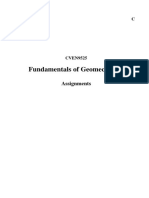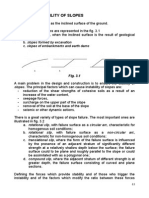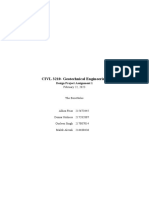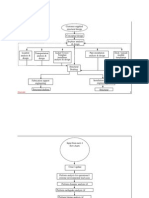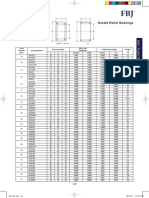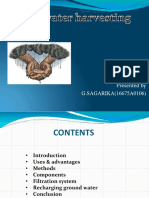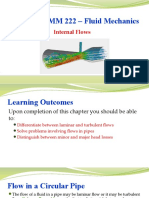Steel Structures - Lecture 2
Uploaded by
Mr. Danish SaeedSteel Structures - Lecture 2
Uploaded by
Mr. Danish SaeedSteel Structures 2/16/2023
Spring 2023
Steel Structures
Lecture 2 [Spring 2023]
Engr. Danish Saeed
Lecturer
Department of Civil Engineering
KFUEIT, RYK
STANDARD CROSS-SECTIONAL SHAPES
• In the design process outlined earlier, one of the objectives — and
the primary emphasis of this course — is the selection of the
appropriate cross sections for the individual members of the
structure being designed
• The largest category of standard shapes includes those produced
by hot-rolling.
Engr. Danish Saeed
Lecturer, Khwaja Fareed University of
Engineering & IT, RYK 1
Steel Structures 2/16/2023
Spring 2023
STANDARD CROSS-SECTIONAL SHAPES
• In this manufacturing process, which takes place in a mill, molten
steel is taken from the furnace and poured into a continuous casting
system where the steel solidifies but is never allowed to cool
completely.
• The hot steel passes through a series of rollers that squeeze the
material into the desired cross-sectional shape
STANDARD CROSS-SECTIONAL SHAPES
• Cross sections of some of the more commonly used hot-rolled
shapes are shown in Figures on next slides .
• The dimensions and designations of the standard available shapes
are defined in the ASTM standards (ASTM, 2005b)
Engr. Danish Saeed
Lecturer, Khwaja Fareed University of
Engineering & IT, RYK 2
Steel Structures 2/16/2023
Spring 2023
STANDARD CROSS-SECTIONAL SHAPES
• The W-shape, also called a wide-flange shape, consists of two
parallel flanges separated by a single web. The orientation of these
elements is such that the cross section has two axes of symmetry.
• A typical designation would be “W18 × 50,” where W indicates the
type of shape, 18 is the nominal depth (in inches) parallel to the
web, and 50 is the weight in pounds per foot of length.
• Cross section is of a W18 × 50 is shown in figure 2.1 on next slide.
STANDARD CROSS-SECTIONAL SHAPES
Figure: 2.1: Typical W shaped cross section
6
Engr. Danish Saeed
Lecturer, Khwaja Fareed University of
Engineering & IT, RYK 3
Steel Structures 2/16/2023
Spring 2023
STANDARD CROSS-SECTIONAL SHAPES
• HP-shapes are similar to W-shapes and are commonly used as H-
piles in bearing pile foundations.
• HP-shapes have thicker flanges and webs compared to W-sections,
and the nominal depth of these sections is usually approximately
equal to the flange width, with the flange and web thicknesses
approximately equal.
• The thick webs help to resist the high impact loads that these
sections are subjected to during pile driving operations
STANDARD CROSS-SECTIONAL SHAPES
Figure: 2.2: Typical HP shaped cross section
8
Engr. Danish Saeed
Lecturer, Khwaja Fareed University of
Engineering & IT, RYK 4
Steel Structures 2/16/2023
Spring 2023
STANDARD CROSS-SECTIONAL SHAPES
• The American Standard, or S-shape, is similar to the W-shape in
having two parallel flanges, a single web, and two axes of
symmetry.
• The difference is in the proportions: The flanges of the W are wider
in relation to the web than are the flanges of the S.
• In addition, the outside and inside faces of the flanges of the W-
shape are parallel, whereas the inside faces of the flanges of the S-
shape slope with respect to the outside faces.
STANDARD CROSS-SECTIONAL SHAPES
• An example of the designation of an S-shape is “S18 × 70,” with the
S indicating the type of shape, and the two numbers giving the
depth in inches and the weight in pounds per foot. This shape was
formerly called an I-beam.
Figure: 2.3: American Standard S shape 10
Engr. Danish Saeed
Lecturer, Khwaja Fareed University of
Engineering & IT, RYK 5
Steel Structures 2/16/2023
Spring 2023
STANDARD CROSS-SECTIONAL SHAPES
• The angle shapes are available in either equal-leg or unequal-leg
versions.
• A typical designation would be “L6 × 6 × 3⁄4” or “L6 × 4 × 5⁄8.”
• The three numbers are the lengths of each of the two legs as
measured from the corner, or heel, to the toe at the other end of
the leg, and the thickness, which is the same for both legs.
• In the case of the unequal-leg angle, the longer leg dimension is
always given first.
• An equal and unequal leg angle shapes are shown in figure 2.4.
11
STANDARD CROSS-SECTIONAL SHAPES
Figure: 2.4: Equal leg and unequal leg angle shapes 12
Engr. Danish Saeed
Lecturer, Khwaja Fareed University of
Engineering & IT, RYK 6
Steel Structures 2/16/2023
Spring 2023
STANDARD CROSS-SECTIONAL SHAPES
• The American Standard Channel, or C-shape, has two flanges and a
web, with only one axis of symmetry; it carries a designation such
as “C9 × 20.”
• This notation is similar to that for W- and S-shapes, with the first
number giving the total depth in inches parallel to the web and the
second number the weight in pounds per linear foot.
• The inside faces of the flanges are sloping, just as with the
American Standard S shape.
13
STANDARD CROSS-SECTIONAL SHAPES
Figure 2.5: American Standard Channel, C Shape
14
Engr. Danish Saeed
Lecturer, Khwaja Fareed University of
Engineering & IT, RYK 7
Steel Structures 2/16/2023
Spring 2023
STANDARD CROSS-SECTIONAL SHAPES
• The Structural Tee is produced by splitting an I-shaped member at
mid depth. This shape is sometimes referred to as a split-tee.
• The prefix of the designation is either WT, ST, or MT, depending on
which shape is the “parent.”
• For example, a WT18 × 105 has a nominal depth of 18 inches and a
weight of 105 pounds per foot, and is cut from a W36 × 210.
• Similarly, an ST10 × 33 is cut from an S20 × 66
15
STANDARD CROSS-SECTIONAL SHAPES
Figure 2.6: Structural Tee Shape
16
Engr. Danish Saeed
Lecturer, Khwaja Fareed University of
Engineering & IT, RYK 8
Steel Structures 2/16/2023
Spring 2023
STANDARD CROSS-SECTIONAL SHAPES
• Other frequently used cross-sectional shapes are shown in Figure
2.7 on next slide.
• Bars can have circular, square, or rectangular cross sections.
• If the width of a rectangular shape is 8 inches or less, it is classified
as a bar.
• If the width is more than 8 inches, the shape is classified as a plate.
17
STANDARD CROSS-SECTIONAL SHAPES
• The usual designation for both is the abbreviation PL (for plate,
even though it could actually be a bar) followed by the thickness in
inches, the width in inches, and the length in feet and inches; for
example, PL 3⁄8 × 5 × 3′-21⁄2″.
• Although plates and bars are available in increments of 1⁄16 inch, it
is customary to specify dimensions to the nearest 1⁄8 inch.
• Bars and plates are formed by hot-rolling.
18
Engr. Danish Saeed
Lecturer, Khwaja Fareed University of
Engineering & IT, RYK 9
Steel Structures 2/16/2023
Spring 2023
STANDARD CROSS-SECTIONAL SHAPES
19
Figure 2.7: Steel Bar and Plate shapes
STANDARD CROSS-SECTIONAL SHAPES
• Also shown in Figure 2.8 are hollow shapes, which can be produced
either by bending plate material into the desired shape and welding
the seam or by hot-working to produce a seamless shape.
• Most hollow structural sections available in the United States today
are produced by cold-forming and welding.
• The shapes are categorized as steel pipe, round HSS, and square
and rectangular HSS.
• The designation HSS is for “Hollow Structural Sections.”
20
Engr. Danish Saeed
Lecturer, Khwaja Fareed University of
Engineering & IT, RYK 10
Steel Structures 2/16/2023
Spring 2023
STANDARD CROSS-SECTIONAL SHAPES
• Steel pipe is available as standard, extra-strong, or double-extra-
strong, with designations such as Pipe 5 Std., Pipe 5 x-strong, or
Pipe 5 xx-strong, where 5 is the nominal outer diameter in inches.
Figure 2.8: Hollow Structural Shapes 21
STANDARD CROSS-SECTIONAL SHAPES
• In most cases, one of these standard shapes will satisfy design
requirements.
• If the requirements are especially severe, then a built-up section,
such as one of those shown in Figure 2.11, may be needed.
• Sometimes a built-up shape must be used because none of the
standard rolled shapes are large enough; that is, the cross section
does not have enough area or moment of inertia.
• In such cases, plate girders can be used.
• These can be I-shaped sections, with two flanges and a web, or box
sections, with two flanges and two webs.
22
Engr. Danish Saeed
Lecturer, Khwaja Fareed University of
Engineering & IT, RYK 11
Steel Structures 2/16/2023
Spring 2023
STANDARD CROSS-SECTIONAL SHAPES
• The components can be welded together and can be designed to
have exactly the properties needed.
• Built-up shapes can also be created by attaching two or more
standard rolled shapes to each other.
• A widely used combination is a pair of angles placed back-to-back
and connected at intervals along their length.
• This is called a double-angle shape.
• Another combination is the double-channel shape.
23
STANDARD CROSS-SECTIONAL SHAPES
Figure 2.9: Commonly used built up shapes
24
Engr. Danish Saeed
Lecturer, Khwaja Fareed University of
Engineering & IT, RYK 12
Steel Structures 2/16/2023
Spring 2023
STANDARD CROSS-SECTIONAL SHAPES
25
Reference Books
Book Title (Edition) Author Chapter/Topic Number
Steel Design (14th) William T. Segui Chapter 1
Topic 1.6
Structural Abi Aghayere, Chapter 1
Steel Design - A PRACTICE- Jason Vigil Topic 1.4
ORIENTED APPROACH
Engr. Danish Saeed
Lecturer, Khwaja Fareed University of
Engineering & IT, RYK 13
You might also like
- Fundamentals of Geomechanics: AssignmentsNo ratings yetFundamentals of Geomechanics: Assignments14 pages
- Structural Engineering: Matrix Methods of AnalysisNo ratings yetStructural Engineering: Matrix Methods of Analysis21 pages
- Assignment-3: CE3350 (Shear Strength of Soils) : Due Date: For Self-Learning, No Need To Submit The SolutionsNo ratings yetAssignment-3: CE3350 (Shear Strength of Soils) : Due Date: For Self-Learning, No Need To Submit The Solutions6 pages
- Structural Engineering: Prestressed ConcreteNo ratings yetStructural Engineering: Prestressed Concrete14 pages
- Roscoe and Hvorselev Boundary ConditionsNo ratings yetRoscoe and Hvorselev Boundary Conditions7 pages
- Lecture4 3-d Stress Tensor and Equilibrium EquationsNo ratings yetLecture4 3-d Stress Tensor and Equilibrium Equations18 pages
- Assessment: Final Exam Content:: Textbook: Brajam. Das, "Principles of Geotechnical Engineering", 7the. (Chapter 12)No ratings yetAssessment: Final Exam Content:: Textbook: Brajam. Das, "Principles of Geotechnical Engineering", 7the. (Chapter 12)78 pages
- Advanced Structural Mechanics (CSE 20204) Lecture 3: OutlineNo ratings yetAdvanced Structural Mechanics (CSE 20204) Lecture 3: Outline8 pages
- Monday-6: Stress Paths, State Paths and Use of Voids RatioNo ratings yetMonday-6: Stress Paths, State Paths and Use of Voids Ratio83 pages
- Engineering Mechanics: Statics: Structural AnalysisNo ratings yetEngineering Mechanics: Statics: Structural Analysis75 pages
- Effect of The Axis of Moment Equilibrium in Slope Stability AnalysisNo ratings yetEffect of The Axis of Moment Equilibrium in Slope Stability Analysis10 pages
- Geotechnical Characterization of The Subsoil of Pisa Tower: January 2003No ratings yetGeotechnical Characterization of The Subsoil of Pisa Tower: January 200340 pages
- The University of Sydney Faculty of Engineering & It (School of Civil Engineering)No ratings yetThe University of Sydney Faculty of Engineering & It (School of Civil Engineering)6 pages
- Lecture 1 Theory of Elasticity and Plasticity PDFNo ratings yetLecture 1 Theory of Elasticity and Plasticity PDF11 pages
- Das Seely (1985) Uplift Capacity of Pipe Piles in Saturated ClayNo ratings yetDas Seely (1985) Uplift Capacity of Pipe Piles in Saturated Clay4 pages
- S2-Finite Element Analysis For Geomechanics (516) .Text - MarkedNo ratings yetS2-Finite Element Analysis For Geomechanics (516) .Text - Marked2 pages
- Lec-09 Types of Waves, 3 Circle Method (Example)No ratings yetLec-09 Types of Waves, 3 Circle Method (Example)23 pages
- 1951 - The Bearing Capacity of Clays - Building Research Congress PDFNo ratings yet1951 - The Bearing Capacity of Clays - Building Research Congress PDF10 pages
- Keçeli - 2012 - Soil Parameters Which Can Be Determined With Seismic Velocities100% (1)Keçeli - 2012 - Soil Parameters Which Can Be Determined With Seismic Velocities13 pages
- Effect of Discrete Columns On Shear Stress Distribution in Liquefiable SoilNo ratings yetEffect of Discrete Columns On Shear Stress Distribution in Liquefiable Soil10 pages
- Introduction To Geotechnical Earthquake EngineeringNo ratings yetIntroduction To Geotechnical Earthquake Engineering29 pages
- Equilibrium: Summing All Forces in The X Direction Where FX The Body Force Per Unit VolumeNo ratings yetEquilibrium: Summing All Forces in The X Direction Where FX The Body Force Per Unit Volume6 pages
- Example 1: Generation of A Bearing Graph For An Open End Diesel HammerNo ratings yetExample 1: Generation of A Bearing Graph For An Open End Diesel Hammer5 pages
- 4a - CRITICAL STATE OF SOIL MECHANICS Light BKGRD Black Fonts-27092020No ratings yet4a - CRITICAL STATE OF SOIL MECHANICS Light BKGRD Black Fonts-2709202059 pages
- Artigo - Numerical Studies of Anchored Sheet Pile Wall Behavior Constructed in Cut and Fill CoNo ratings yetArtigo - Numerical Studies of Anchored Sheet Pile Wall Behavior Constructed in Cut and Fill Co9 pages
- Simpli Ed Approach For Design of Raft Foundations Against Fault Rupture. Part II: Soil-Structure InteractionNo ratings yetSimpli Ed Approach For Design of Raft Foundations Against Fault Rupture. Part II: Soil-Structure Interaction15 pages
- Learning Outcomes: Fakulti Kejuruteraan Awam Universiti Teknologi MaraNo ratings yetLearning Outcomes: Fakulti Kejuruteraan Awam Universiti Teknologi Mara3 pages
- Towards A Unified Soil Mechanics Theory: The Use of Effective Stresses in Unsaturated Soils, Revised EditionFrom EverandTowards A Unified Soil Mechanics Theory: The Use of Effective Stresses in Unsaturated Soils, Revised EditionNo ratings yet
- A Catalogue of Details on Pre-Contract Schedules: Surgical Eye Centre of Excellence - KathFrom EverandA Catalogue of Details on Pre-Contract Schedules: Surgical Eye Centre of Excellence - KathNo ratings yet
- Buckling Under Compression Forces TestExperiment Lab ReportNo ratings yetBuckling Under Compression Forces TestExperiment Lab Report8 pages
- Elastically Coupled Beam Apparatus: Instructional ManualNo ratings yetElastically Coupled Beam Apparatus: Instructional Manual9 pages
- Engineering Mechanics Lab Manual - FinalNo ratings yetEngineering Mechanics Lab Manual - Final45 pages
- Flow Chart Pre Service and Inservice AnalysisNo ratings yetFlow Chart Pre Service and Inservice Analysis29 pages
- Masonry-Finishings-and-Paint-Works-HandoutsNo ratings yetMasonry-Finishings-and-Paint-Works-Handouts34 pages
- All You Need To Refresh Your Knowledge of Pumps100% (1)All You Need To Refresh Your Knowledge of Pumps48 pages
- Dura-Blue: PVC Municipal Water Distribution Pipe (4 - 12")No ratings yetDura-Blue: PVC Municipal Water Distribution Pipe (4 - 12")3 pages
- Prepared by For The California High-Speed Rail AuthorityNo ratings yetPrepared by For The California High-Speed Rail Authority47 pages
- Madurai - 25.00LL Capacitty 18m Staging OHT - KOCHADAI-Layout1No ratings yetMadurai - 25.00LL Capacitty 18m Staging OHT - KOCHADAI-Layout11 page
- Investigation of Discharge Coefficient of Louvre Openings in - Iaqvec2023 - 02030No ratings yetInvestigation of Discharge Coefficient of Louvre Openings in - Iaqvec2023 - 020308 pages
- Prosedur Uji Bantalan Beton Arema Dan enNo ratings yetProsedur Uji Bantalan Beton Arema Dan en2 pages
- FINAL SHOP DRAWING Friday - 12-01-2024-ModelNo ratings yetFINAL SHOP DRAWING Friday - 12-01-2024-Model1 page
- Fosroc Conplast SP454S: High Performance Superplasticising AdmixtureNo ratings yetFosroc Conplast SP454S: High Performance Superplasticising Admixture2 pages
- 03 01 30 - Maintenance of Cast-in-Place ConcreteNo ratings yet03 01 30 - Maintenance of Cast-in-Place Concrete11 pages
- Centrifugal Pump Working Principle With DiagramNo ratings yetCentrifugal Pump Working Principle With Diagram12 pages
- Appendix+M.6+ +Foundations+Report+ +407ETRNo ratings yetAppendix+M.6+ +Foundations+Report+ +407ETR45 pages
- Structural Engineering: Matrix Methods of AnalysisStructural Engineering: Matrix Methods of Analysis
- Assignment-3: CE3350 (Shear Strength of Soils) : Due Date: For Self-Learning, No Need To Submit The SolutionsAssignment-3: CE3350 (Shear Strength of Soils) : Due Date: For Self-Learning, No Need To Submit The Solutions
- Lecture4 3-d Stress Tensor and Equilibrium EquationsLecture4 3-d Stress Tensor and Equilibrium Equations
- Assessment: Final Exam Content:: Textbook: Brajam. Das, "Principles of Geotechnical Engineering", 7the. (Chapter 12)Assessment: Final Exam Content:: Textbook: Brajam. Das, "Principles of Geotechnical Engineering", 7the. (Chapter 12)
- Advanced Structural Mechanics (CSE 20204) Lecture 3: OutlineAdvanced Structural Mechanics (CSE 20204) Lecture 3: Outline
- Monday-6: Stress Paths, State Paths and Use of Voids RatioMonday-6: Stress Paths, State Paths and Use of Voids Ratio
- Engineering Mechanics: Statics: Structural AnalysisEngineering Mechanics: Statics: Structural Analysis
- Effect of The Axis of Moment Equilibrium in Slope Stability AnalysisEffect of The Axis of Moment Equilibrium in Slope Stability Analysis
- Geotechnical Characterization of The Subsoil of Pisa Tower: January 2003Geotechnical Characterization of The Subsoil of Pisa Tower: January 2003
- The University of Sydney Faculty of Engineering & It (School of Civil Engineering)The University of Sydney Faculty of Engineering & It (School of Civil Engineering)
- Das Seely (1985) Uplift Capacity of Pipe Piles in Saturated ClayDas Seely (1985) Uplift Capacity of Pipe Piles in Saturated Clay
- S2-Finite Element Analysis For Geomechanics (516) .Text - MarkedS2-Finite Element Analysis For Geomechanics (516) .Text - Marked
- 1951 - The Bearing Capacity of Clays - Building Research Congress PDF1951 - The Bearing Capacity of Clays - Building Research Congress PDF
- Keçeli - 2012 - Soil Parameters Which Can Be Determined With Seismic VelocitiesKeçeli - 2012 - Soil Parameters Which Can Be Determined With Seismic Velocities
- Effect of Discrete Columns On Shear Stress Distribution in Liquefiable SoilEffect of Discrete Columns On Shear Stress Distribution in Liquefiable Soil
- Introduction To Geotechnical Earthquake EngineeringIntroduction To Geotechnical Earthquake Engineering
- Equilibrium: Summing All Forces in The X Direction Where FX The Body Force Per Unit VolumeEquilibrium: Summing All Forces in The X Direction Where FX The Body Force Per Unit Volume
- Example 1: Generation of A Bearing Graph For An Open End Diesel HammerExample 1: Generation of A Bearing Graph For An Open End Diesel Hammer
- 4a - CRITICAL STATE OF SOIL MECHANICS Light BKGRD Black Fonts-270920204a - CRITICAL STATE OF SOIL MECHANICS Light BKGRD Black Fonts-27092020
- Artigo - Numerical Studies of Anchored Sheet Pile Wall Behavior Constructed in Cut and Fill CoArtigo - Numerical Studies of Anchored Sheet Pile Wall Behavior Constructed in Cut and Fill Co
- Simpli Ed Approach For Design of Raft Foundations Against Fault Rupture. Part II: Soil-Structure InteractionSimpli Ed Approach For Design of Raft Foundations Against Fault Rupture. Part II: Soil-Structure Interaction
- Learning Outcomes: Fakulti Kejuruteraan Awam Universiti Teknologi MaraLearning Outcomes: Fakulti Kejuruteraan Awam Universiti Teknologi Mara
- Towards A Unified Soil Mechanics Theory: The Use of Effective Stresses in Unsaturated Soils, Revised EditionFrom EverandTowards A Unified Soil Mechanics Theory: The Use of Effective Stresses in Unsaturated Soils, Revised Edition
- A Catalogue of Details on Pre-Contract Schedules: Surgical Eye Centre of Excellence - KathFrom EverandA Catalogue of Details on Pre-Contract Schedules: Surgical Eye Centre of Excellence - Kath
- Buckling Under Compression Forces TestExperiment Lab ReportBuckling Under Compression Forces TestExperiment Lab Report
- Elastically Coupled Beam Apparatus: Instructional ManualElastically Coupled Beam Apparatus: Instructional Manual
- Dura-Blue: PVC Municipal Water Distribution Pipe (4 - 12")Dura-Blue: PVC Municipal Water Distribution Pipe (4 - 12")
- Prepared by For The California High-Speed Rail AuthorityPrepared by For The California High-Speed Rail Authority
- Madurai - 25.00LL Capacitty 18m Staging OHT - KOCHADAI-Layout1Madurai - 25.00LL Capacitty 18m Staging OHT - KOCHADAI-Layout1
- Investigation of Discharge Coefficient of Louvre Openings in - Iaqvec2023 - 02030Investigation of Discharge Coefficient of Louvre Openings in - Iaqvec2023 - 02030
- Fosroc Conplast SP454S: High Performance Superplasticising AdmixtureFosroc Conplast SP454S: High Performance Superplasticising Admixture

